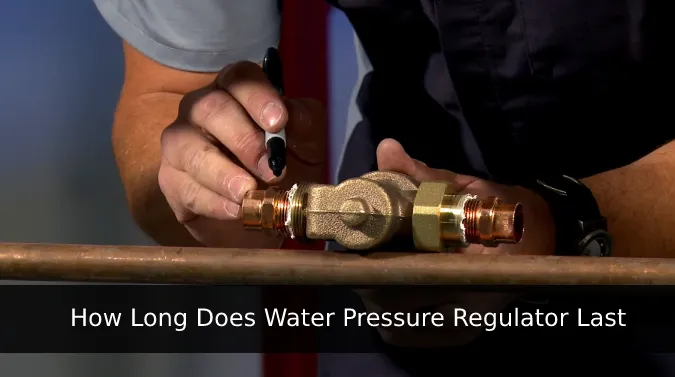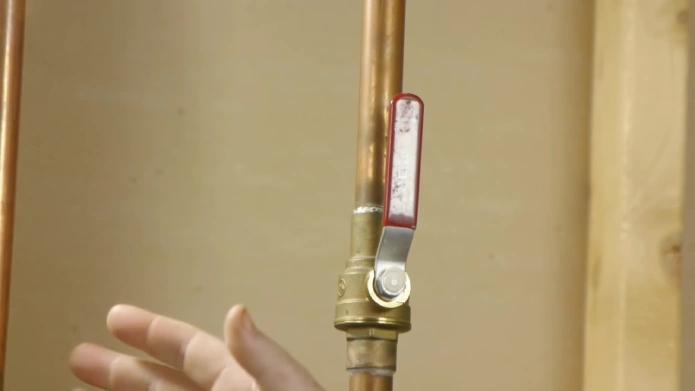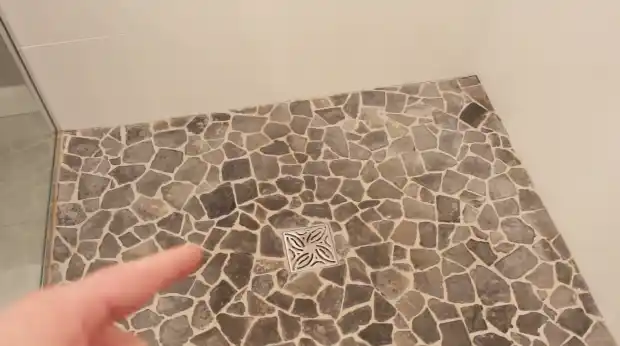Last Updated on May 16, 2023
A water pressure regulator controls the water pressure throughout your home, ensuring that it stays within safe levels.
But just like other components in your plumbing system, the water pressure regulator won’t last forever. So, how long does a water pressure regulator last?
While its typical lifespan falls between 10 to 15 years, some regulators can begin to malfunction as early as three years. Conversely, other regulators can still be going strong even after 20 years.
Several factors, such as the regulator’s overall quality, maintenance level, and usage, significantly determine its lifespan.
Let’s explore some factors that could affect its lifespan, plus how to tell when it might be time for a replacement.
How Long Does Water Pressure Regulator Last: Factors Affect Lifespan

Your water pressure regulator has a certain lifespan, and there are several things that can influence how long it will last.
Factors such as water quality, location of the regulator installation, and frequency of use all play a role in its longevity. Let’s take a closer look at all the things that can influence your regulator’s life.
1. Quality of Materials
The quality of materials used in water pressure regulators plays a vital role in determining their lifespan. Stainless steel is the most durable material that can last up to 20 years or more due to its corrosion-resistant and rust-resistant properties.
Bronze and brass regulators are also durable, resistant to corrosion, rust, and other forms of degradation. But, they require proper maintenance to last between 15 to 20 years.
In contrast, aluminum regulators are lightweight and corrosion-resistant but less durable than stainless steel, bronze, or brass. As such, a well-maintained aluminum regulator can last between 10 to 15 years.
Nonetheless, plastic regulators are the least durable and prone to cracking, breaking, and other types of degradation. With proper maintenance, they can last between 5 to 10 years.
So, it would be in your best interest to invest in a water pressure regulator made of stainless steel, bronze, brass, or aluminum to ensure maximum durability.
2. Installation
Another key factor that affects a water pressure regulator’s lifespan is the quality of installation. It’s super important to have a knowledgeable, professional plumber install the device to ensure that it’s set up correctly.
A poorly-installed regulator can not only cause premature failure but can also result in water pressure issues throughout your home.
If you decide to install it yourself, make sure you thoroughly research the process and follow the manufacturer’s guidelines closely.
Even something as simple as placing the regulator in the wrong location or improperly attaching the connections can lead to a reduced lifespan or even damage to your plumbing system.
3. Water Quality

The water quality that flows through your pressure regulator can also impact its lifespan. Factors like hard water or water with high levels of sediment and minerals can take a toll on the regulator over time.
Eventually, the buildup of these materials reduces the regulator’s effectiveness and durability. One solution to address poor water quality is to install a water softener or filtration system for your home.
These systems can protect the pressure regulator, improve your appliances’ efficiency, and extend your plumbing’s life. Ultimately, providing clean and clear water helps keep your pressure regulator functioning at its best.
4. Usage
The longevity of water pressure regulators is significantly influenced by the frequency and intensity of their usage.
Similar to other devices, a higher degree of usage can expedite the process of wear and tear, leading to a shortened operational lifespan.
For instance, a pressure-reducing valve installed in a bustling commercial edifice, where water consumption is substantial, will naturally experience quicker degradation than one set up in a residential property with lower water usage.
Being cognizant of this correlation can help you to effectively anticipate the appropriate time to replace your regulator, thereby ensuring optimal performance and preventing potential issues.
5. Maintenance
Ensuring the longevity of your water pressure regulator requires diligent and proper maintenance, with an important focus on maintaining cleanliness.
Regular cleaning helps to thwart the accumulation of dirt and debris, potentially leading to corrosion and other damage.
To effectively preserve the integrity of your regulator, it’s crucial to consult the manufacturer’s guidelines on recommended cleaning methods and the appropriate frequency for maintenance checks.
By implementing a consistent maintenance routine, you’ll be able to identify potential issues early on, allowing you to address them proactively and prevent them from escalating into more significant problems.
6. Pressure Differential

Another factor that can affect how long a water pressure-reducing valve lasts is the pressure differential.
The pressure differential is basically the difference between the water pressure coming into your home and the pressure that the regulator is supposed to maintain.
When there’s a big difference between these two pressures, the regulator has to work extra hard to keep everything balanced.
This extra work puts more stress on the regulator’s components, wearing them out faster and shortening the overall lifespan of the device.
7. Environmental Conditions
The longevity of a water pressure regulator is significantly influenced by the environmental conditions in which it is installed.
Harsh environments, characterized by extreme temperatures, elevated humidity levels, or the presence of corrosive chemicals, can accelerate the wear and tear of the regulator components. This ultimately leads to a shorter lifespan.
The corrosion and degradation of materials caused by these unfavorable conditions necessitate more frequent replacement of the water pressure regulator as opposed to those installed in milder, controlled environments.
Consequently, to ensure optimal performance and durability of your water pressure regulator, it is crucial to consider the surrounding conditions and opt for a more protected installation location whenever possible.
How Do I Know If My Water Pressure Regulator Is Bad?
A faulty water pressure regulator can lead to a variety of plumbing issues and discomfort in your daily life.
Identifying the signs of a bad regulator is crucial for maintaining optimal water pressure and preventing damage to your pipes, appliances, and fixtures. Here are some signs your water pressure regulator isn’t working.
1. Inconsistent Water Pressure
One way to tell if your water pressure regulator might be going bad is if you’re experiencing inconsistent water pressure throughout your home.
This means that the water might be gushing out super strong from one faucet and then barely trickling from another.
Or, maybe you’ve even noticed that the water pressure varies from one day to another. This erratic behavior can be quite frustrating, right?
Well, the issue could be due to a malfunctioning water pressure regulator, as it’s responsible for maintaining a consistent water pressure level in your plumbing system.
2. Noisy Pipes

Another clear sign that your pressure regulator might be having problems is if you hear strange noises from your pipes whenever you turn on the faucet.
When the water pressure is too high, it forces the water to move through the pipes at a faster speed, which can create those banging or knocking sounds you’ve been hearing.
If you notice this happening, it’s likely that your regulator is not working properly and needs to be either adjusted or replaced.
Ignoring this issue could lead to more serious damage to your plumbing system, so it’s best to address it as soon as possible.
3. Leaking Faucet or Toilet
A constant drip from your faucet or toilet may not seem like a big deal, but it could actually mean your water pressure regulator isn’t doing its job.
When the regulator fails, it can cause the water pressure in your plumbing system to spike, which in turn can damage the seals in your fixtures, leading to leaks.
Suppose you’re constantly dealing with dripping faucets or running toilets. In that case, it might be more than just a minor annoyance. It could actually be an indicator that your water pressure regulator is going bad.
It’s definitely worth having a plumber take a look to pinpoint the problem, as fixing the regulator could save you from dealing with more serious plumbing issues down the line.
4. High Water Bills
An increase in your water bill without a reasonable explanation may indicate a problem with your water pressure regulator.
A faulty regulator can lead to excess water usage, resulting in a spike in your monthly water expenses.
To determine if this is the issue, monitor your daily water consumption and compare it to the average usage for households of a similar size in your area.
If you find that you are using more water than expected, it might be a sign the pressure regulator is not functioning correctly. Consult a plumbing professional to inspect your system and diagnose the issue accurately.
5. Shortened Lifespan of Plumbing Fixtures

Plumbing fixtures, such as faucets and toilets, are designed to last for several years.
However, the unusually high water pressure caused by a faulty regulator can cause undue wear and tear on these fixtures, significantly reducing their lifespan.
To check whether the high water pressure is causing premature wear on your fixtures, observe any recurring problems. There might be leaks and drips, which might indicate that the internal components are struggling to handle the force of the water.
Keep an ongoing maintenance record for your fixtures to compare their current performance with the manufacturer’s suggested lifespan.
If you find that your plumbing fixtures are deteriorating faster than they should be, consult a plumbing expert to measure the water pressure in your system and identify any underlying issues with your regulator.
6. Water Hammer
Water hammer refers to the loud banging or thumping sound you might hear when turning off a faucet or valve. This sound is caused by the sudden stoppage of water flow, which sends a pressure wave through the pipes.
A bad water pressure regulator can result in higher than the necessary water pressure in your system, exacerbating water hammer issues.
How Can You Identify The Best Quality Water Pressure Reducing Valve?
To determine the best quality water pressure-reducing valve, there are a few important factors to consider. The valve should have a high-quality finish, as a smooth polished finish can prevent corrosion and rust build-up, extending the product’s lifespan.
Pay attention to the pressure settings of the valve, it’s crucial to select a model that can handle the maximum pressure of your water supply while offering an adjustable pressure setting.
Rust resistance is another important factor. Consider valves made with rust and corrosion-resistant materials like brass or stainless steel, ensuring continued proper function over time.
Ease of installation shouldn’t be overlooked either. Choosing a valve that comes with clear instructions and can be installed with ease, even for those not experienced with plumbing, can save time and reduce frustration.
Consider reviewing top-rated models to save yourself time and hassle when selecting the best water pressure reducing valve for your specific needs.
It’s worth noting that we’ve already reviewed the top-rated models on the market. Checking our reviews can be a hassle-free way to find a high-quality valve that meets your needs.
What Should Water Pressure Regulator Be Set At?
A water pressure regulator should be set within the range of 40 to 70 psi, as this provides an optimal balance for home use.
This setting ensures that your residential plumbing system operates efficiently and safely without causing unnecessary strain on fixtures and appliances.
Maintaining the pressure within this recommended range prevents potential leaks, damage, and costly repairs while still enjoying adequate water flow for daily activities.
Adjust the regulator as needed to achieve the desired pressure, bearing in mind the factory setting usually lies between 45 to 55 psi.
Can You Clean a Water Pressure Regulator?

You can clean a water pressure regulator by following a series of steps. First, turn off your home’s main water supply and locate the regulator near the main shutoff valve.
D disconnect the regulator from the pipes using a wrench and disassemble it according to the manufacturer’s guidelines. Inspect the interior for debris, sediment, or mineral buildup that may be causing issues.
Soak the removed parts in a calcium lime remover solution for several hours to clean the regulator, then rinse with water.
After reassembling the regulator, reconnect it to the pipes, turn on the main water supply, and test the water pressure to ensure proper functioning.
How Often Should Water Pressure Regulator Be Replaced?
Plumbing experts recommend replacing your water pressure regulator every eight years to keep your water system running smoothly.
While these regulators typically have a life expectancy of 10 to 15 years, a proactive replacement can mitigate the risk of malfunctions and suboptimal water pressure in your home or building.
This recommendation contributes to the overall longevity of your plumbing system, but it also ensures a reliable and consistent water supply.
Ensure Plumbing Security with a Pressure Regulator Inspection
In essence, diligent monitoring of your water pressure regulator plays a crucial role in preserving a secure and pleasant living environment.
Although these regulators are typically engineered to function for a decade or more, their actual longevity can differ based on aspects such as the device’s quality, upkeep, and frequency of use.
As a conscientious homeowner, it is vital for you to consistently examine and maintain your water pressure regulators, ensuring their optimal performance.
In doing so, you not only safeguard your plumbing infrastructure and home appliances from potential harm but also guarantee a consistently well-regulated water pressure. This contributes to your residence’s overall comfort and satisfaction for the long haul.



